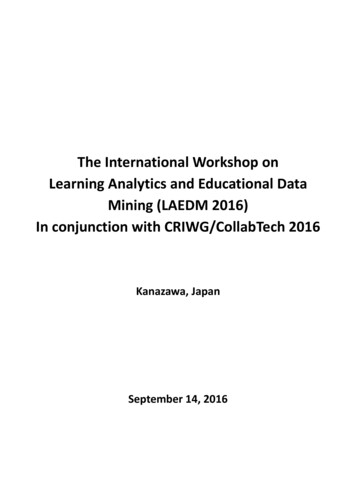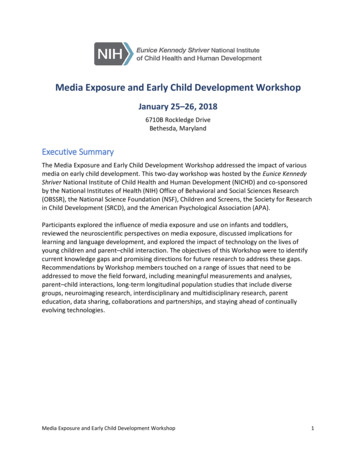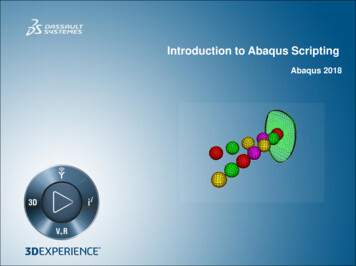
Transcription
The International Workshop onLearning Analytics and Educational DataMining (LAEDM 2016)In conjunction with CRIWG/CollabTech 2016Kanazawa, JapanSeptember 14, 2016
PrefaceThe aim of the workshop is to bring together international scholars and researchers working onvarious aspects of interest regarding recent developments of big data analytics in educational fields.In this workshop, a keynote speech is given and a total of 11 papers are accepted for presentation.The topics of the papers presented in this workshop include learning technologies and tooldevelopments for personalized and adaptive learning, deployment and implementation of learninganalytics, theoretical and pedagogical issues, and privacy aspects of learning analytics.Workshop OrganizerProfessor K. Robert Lai, Center for Big Data and Digital Convergence, Yuan Ze University, TaiwanProfessor Weiqin Chen, College of Applied Science, Oslo and Akershus University, NorwayProgram CommitteeGwo‐dong Chen, National Central University, TaiwanYong‐Sang Cho, Korean Education and Research Information Service, South KoreaKenji Hirata, University of Tokyo, JapanTore Hoel, Oslo and Akershus University College of Applied Sciences, NorwayUlrich Hoppe, University of Duisburg‐Essen, GermanyJon Mason, Charles Darwin University, AustraliaHiroaki Ogata, Kyushu University, JapanShu‐Fen Tseng, Yuan Ze University, TaiwanBarbara Wasson, University of Bergen, Norway
ProgramDate: September 14, 2016Venue: Seminar Room A of Shiinoki Cultural Complex, Ishikawa Prefecture10:00‐12:30 morning session (Section chairs: Professor K. Robert Lai)10:00‐10:30 Keynote speech ( Professor Dai Griffiths, University of Bolton, United Kingdom)Title: Learning analytics state‐of‐affairs – summing up three years of experience building acommunity of stakeholders in schools, universities and the workplace10:30-12:30 Paper presentation sessionID Authors and paper titlePageRen-Hao Pan, Van Lam Ho, Phan Dinh Van, Hsiu-Chen Hsu, Robert K Lai and1 Chien-Lung Chan. Development of daily activity and lifestyle data visualization tool1for the college student learning analytics811Sébastien ANDRÉ , Atsushi SHIMADA and Hiroaki OGATA . AutomaticSummarization System of Lecture SlidesRyo ABO, Takayuki KOGA, Izumi HORIKOSHI, Kimiaki YAMAZAKI and YasuhisaTAMURA. Data Visualization Framework for Learning Analytics68Cheng-Wei Lee, Huan-Yi Pan, Liang-Chih Yu, Chien-Lung Chan, Chih-Yueh Chou and5 Shu-Fen Tseng. Academic Performance Estimation by Visualization of Learning10Patterns in Campus Environments9Shu-Fen Tseng, Liang-Chih Yu, Ho-Shing Wu, and Po-Yao Chao. MeasuringEngagement: Student Profiling and the Effects of Remedial Learning Counseling14
12:30‐14:00 lunch14:00‐16:30 afternoon session (Section chairs: Professor Tore Hoel)ID Authors and paper title24Kazuharu Toyokawa. Monitoring Learning Attitude and Engagement from Students’Free-style Comments via Lexicon-based AnalysisYugo Hayashi. Collaborative learning in a knowledge integration task using PCAs:Investigation based on dyad eye movementsPage1822Chen-Yu Lee, Gwo-Haur Hwang, Long-Siang Huang and Hsu-Yu Lee. The Analysis of12 Learning Effectiveness of Chinese Proficiency Test Tutorial System Including26Capability Indicators7133Chyi-In Wu. Computer Assisted Learning to Improve Educational Performance: AStudy of Aboriginal Taiwanese KidsLeo A. Siiman and Margus Pedaste. Response time analytics for evaluating thequality of survey data from school-age studentsTore Hoel and Weiqin Chen. Implications of the European Data ProtectionRegulations for Learning Analytics Design303337
Development of daily activity and lifestyle data visualization tool forthe college student learning analyticsRen-Hao PanVan Lam HoPhan Dinh VanInnovation Center for Big data and Digital Convergence, Yuan Ze University,Taoyuan 330, Taiwan, (R.O.C)E-mail: pan@51donate.comDepartment of Computer Science andEngineering, Yuan Ze University,Taoyuan 330, Taiwan, (R.O.C)E-mail: s999114@mail.yzu.edu.twDepartment of Information Management,Yuan Ze University, Taoyuan 330, Taiwan, (R.O.C)E-mail: dvan2707@due.edu.vnHsiu-Chen HsuRobert K. LaiChien-Lung ChanDepartment of Information Management,Yuan Ze University, Taoyuan 330, Taiwan, (R.O.C)E-mail: s941402@gmail.comDepartment of Computer Science andEngineering, Yuan Ze University,Taoyuan 330, Taiwan, (R.O.C)E-mail: krlai@saturn.yzu.edu.twDepartment of Information Managementand Innovation Center for Big data andDigital Convergence, Yuan Ze University,Taoyuan 330, Taiwan, (R.O.C)E-mail: clchan@saturn.yzu.edu.tw(Corresponding Author)Moreover, a low number of steps taken daily was observed to contribute to the high prevalence of adultobesity in the United States [4]. Sleep efficiency affectsthe neurocognitive function, attention level and academic performance of students at various levels of education. A lack of sleep related to the prefrontal cortex(PFC) can cause weaknesses in learning, attention, decision-making, and normal neurocognitive functioning[5]. Many instruments have been developed to measurephysical activity (PA) and sleep, but a new method formeasuring regular PA and sleep and analyzing the associations with cognitive function is needed [6]. The aimof this study was to develop a new approach for investigation of PA and attention capacity. We observed thedaily activities of students at Yuan Ze University byutilizing a wearable tracking device and assessed attention capacity in order to examine the relationships ofPA and lifestyle with memory and attention capacity.AbstractIn this study, 30 college students used a wearabletracking device for 24-hour measurement of daily physical activity and lifestyle factors over a period of 56days. The collected data included heart rate, number ofsteps, activity level, sleep-related information, and calories burned. These data were stored on our Hadoop-based in-memory data warehousing platform. ABehavior Visualization System (BVS) was developed toillustrate the students’ lifestyle and behaviors usingdynamic visualization tools such as line charts, barcharts, etc. A descriptive statistics module, data filtering and exporting tool were also included for advancedactivities analysis for specific individuals or groups. Anassociation analysis of physical activity and learningperformance was conducted using the BVS, with thecriterion that the device was worn for over 20 hours perday. The results revealed that examination performancewas associated with sleep duration during the one dayprior to examination (Pearson correlation coefficient0.365, p 0.05). This finding suggested that using thewearable device for daily physical activity and sleeptracking may have a beneficial effect on students’learning.2. Methods2.1. FactorsThe wearable tracking device used in this researchwas a Fitbit Charge HR, which is produced by Fitbit,Inc. The tracker can record 24 hours of daily information regarding physical activity and lifestyle, including heart rate, calories burned, steps taken, distancemoved, floors climbed, elevation, sedentary duration,duration of light activity, duration of moderate activity,duration of high activity, sleep duration, waking duration, number of awakenings, duration spent in bed,sleep efficiency, sleep start time and depth of sleep. Allmeasured data were synchronized to the Fitbit cloud,then transcribed from the cloud to a Hadoop-basedin-memory data warehousing platform. Table1 showsthe 19 factors measured, the sampling frequency and thetotal amount of recorded data derived from 30 students.Table 1: Factors measured by the tracking device.1. IntroductionPrevious studies have indicated that day-to-dayphysical activity (PA) influences concentration leveland is highly correlated with disease occurrence [1,8,9].For example, attention deficit hyperactivity disorder(ADHD) is a syndrome observed in children and isidentified by investigation of physical activity, including sleep duration and daily activity level [2]. Jeremyreported a positive association between physical activityand sleep [10,11], and a longer duration spent performing moderate or moderate-to-vigorous physical activityhas also been shown to be related to sleep quality [3].#1FactorFrequency Total rec-
12345678910111213141516171819Heart rateCaloriesStepsDistanceFloorsElevationSedentary durationDuration of light activityDuration of moderate activityDuration of high activitySleep durationWaking durationNumber of awakeningsDuration spent in bedSleep efficiencySleep start timeSleep depth - asleepSleep depth - awakeSleep depth - very awake5 nuteminuteDayDayDayDayDayDayDayDayDayspent in bed, sleep efficiency, sleep start time, sleepdepth – asleep, sleep depth – awake, and sleep depth –very awake.All data collected were stored on the Hadoop-basedin-memory data warehousing platform, Impala. Impalais based on the Hadoop distributed file system (HDFS)and has the ability to access terabyte-level data rapidlyusing the in-memory data processing technique. ImpalaSQL can be used to obtain a data summary, implementdata queries, and analyze data in the Impala data warehousing platform. Impala can also be employed to explore information in an interactive manner, and to implement reusable batch processing with the advantagesof high-performance and low-latency SQL queries.Compared with the traditional Client-Server architecture, the In-Memory access framework significantlyenhanced the ability to manage fast and large data distributed write and read tasks. Efficiency is improvedand the amount of time required for data access is reduced; hence, the development of a real-time terabyte-level analytic application was 422.2. Tracking Data CollectionJava programming language was used to design programs and access data through the wearable devicecloud API (Application Programming Interface) forsecure data access. First, data from the wearable devicewere updated by mobile phone using Bluetooth ver. 4.0.The client app next redirected to the tracker authorization page for data collection authentication. A personaltoken was obtained from a callback URL and was applied to synchronize the cloud data. When the abovesteps were completed, a data retrieval program began tocollect data via the JSON exchange format and stored itin the data warehousing platform.2.4. Data ProcessingIn this study, data regarding the daily activities ofstudents were displayed using the BVS as per the dataprocessing workflow shown in Figure 1.2.3. Data Storage & ProcessingIn this research, a Behavior Visualization System(BVS) was developed for data analysis, which had theability to manage a group of tracking devices and synchronize multiple tracker measurement data to the datawarehouse. The collected data had different samplingfrequencies: heart rate was measured every 5 seconds,and calories, steps, distance, floors, elevation, sedentaryduration, duration of light activity, duration of moderateactivity and duration of high activity were measuredevery minute. Data obtained daily included sleep duration, waking duration, number of awakenings, durationFigure 1: Data processing workflow.The data transfer procedure from the tracker to theBVS was as follows: Step 1 – data regarding daily activities of students were collected by the tracker andsynchronized to the cloud [7]. Step 2: The BVS provides authorization and collects data from the cloud fortranscription to the data warehouse. Step 3: Visualization tools implemented using the JavaFX techniquewere applied in the BVS to illustrate activity and lifestyle data in charts (line, bar, scatter) according to timeFigure 2: Display of hourly activities.2
series and user series. The BVS also provided descriptive statistics for individual or group analysis. For advanced analytics, the BVS enabled data filtering bycriterion-setting followed by export to a text file forfurther analysis.histogram, and the filtered data can be exported as aCSV file for further analysis. Figure 4 shows the behavior of the subjects each day for a week. This tool canbe used to present data for each user or data for all usersfor each measured activity. However, the device batteries require recharging after a few days, and other reasons may also result in missing data; hence, a filter forthe length of wear per day was required.3. Results3.1. MaterialsThe device used in this study collected various dataat different frequencies, e.g., heart rate data were collected every 5 seconds, and other data were collectedevery minute or every day. Therefore, management ofthe large amount of data collected (over 30,000 recordsgenerated from a single participant per day) posed achallenge, and data representation for all 30 subjectsduring the study period was also difficult. In addition,the data collected were sometimes incomplete andnon-continuous, as day-to-day activities of the studentsmay render the sensor unable to collect data; for example, when the device was removed during bathing, orwhen the tracker battery was depleted. Thus, if all thedata collected were used, the results obtained throughanalysis would not be close to a representation of thereal activities of the students. Therefore, conditionswere established to filter missing daily physical activities data. In this study, heart rate data were employed asa condition to filter the final data for analysis. Duringperiods in which the tracker was removed, heart ratedata were not obtained, and hence the system must omitthe missing data for that period. The system calculatedthe duration in which heart rate data were obtained in aday, and set the duration for which the tracker was wornas a criterion to provide a filter and enable targetedsubject selection. The following analyses were conducted following filtering of the data using the criterionthat the daily duration of wear must be greater than 20hours.Figure 3: Display of daily activitiesFigure 4: Display of weekly activities.3.2. Activity ProfilingThe BVS provides various visualization and profiling options, which include hourly data presentation,daily activities visualization, and weekly statistics. Figure 2 shows a line chart representing hourly activitiesfrom 0 to 23 hours for each user and for all users on oneday. The system also allows selection of user, activityand date; a line chart is then produced, and comparisonbetween two activities is possible. Figure 3 shows howdaily activities can be visualized as activity data obtained during a measurement period in which the students were attending a class; the BVS can illustrate theactivity histogram of a selected user or the mean of allusers. This system also supports data filtering based onthe number of hours, adjusted by user heart rate data perhour and wear length per day. Users of the BVS areable to set a threshold for refreshing of the visualizedresults in order to observe the changing profile of aFigure 5: Descriptive statistics for daily activity.3.3. Descriptive StatisticsUsing the statistics module, the developed tool canbe used to calculate various descriptive statistical indi-3
cators, such as the means and standard deviations of allactivities of each user or of all users during the researchperiod. Again, the tool is capable of filtering based onthe duration for which heart rate data were obtained perday, and Figure 5 shows the data can be exported forfurther study.that sleep duration on the one day prior to the examination had a positive effect on examination performance(as measured by the examination score). In this study, abrand new method for behavior analysis was introduced,which differed from questionnaire-based analysis orshort-term experiments. A wearable tracking device wasused for 24-hour daily physical activity measurement instudents, and analysis of the association between various activity-related factors and examination performance was conducted. Moreover, a Behavior Visualization System was designed to collect physical activityand lifestyle data such as sleep-related information fromthe cloud and enable statistical analysis and illustrationvia charts, in order that researchers are able to analyzethe physical activity, behavior and lifestyle of subjectsfor related research.4.4. Correlation Analysis between Daily PA andLearning PerformanceUsing the data collected, we were able to analyze thecorrelations between the learning outcome of the 36subjects and various PA-related factors. PA data werefiltered according to the criterion that the device wasworn for over 20 hours per day. Learning outcome wasassessed based on five examination results from everysubject during the investigation period. Associationanalysis was conducted using SPSS after combiningexamination results and PA data from the day prior tothe exam. Table 2 shows the analysis results, whichindicated a positive correlation between sleep durationon the day prior to the examination and examinationoutcome, with a correlation coefficient of 0.365(p 0.05).AcknowledgmentsThis study was supported by the Ministry of Science andTechnology, MOST 102-2221-E-155-027 andMOST104-3115-E-155-002.6. References[1] J. Vanhelst, et al., Physical Activity Is Associated withAttention Capacity in Adolescents. J Pediatr, 2016. 168: p.126-31.e2.[2] F. De Crescenzo, et al., The use of actigraphy in themonitoring of sleep and activity in ADHD: A meta-analysis.Sleep Med Rev, 2016. 26: p. 9-20.[3] M. Kishida and S. Elavsky, An intensive longitudinalexamination of daily physical activity and sleep in midlifewomen. Sleep Health, 2016. 2(1): p. 42-48.[4] D. R. Bassett, Jr., et al., Pedometer-measured physicalactivity and health behaviors in U.S. adults. Med Sci SportsExerc, 2010. 42(10): p. 1819-25.[5] G. Curcio, M. Ferrara, and L. De Gennaro, Sleep loss,learning capacity and academic performance. Sleep Med Rev,2006. 10(5): p. 323-37.[6] C. Lang, et al., The relationship between physical activityand sleep from mid adolescence to early adulthood. Asystematic review of methodological approaches andmeta-analysis. Sleep Med Rev, 2015. 28: p. 28-41.[7] Suzana Loshkovska, Saso Koceski. ICT Innovations2015: Emerging Technologies for Better Living. Springer,2015. p.5 - 8.[8] Y.-J. Tsai, C.-L. Hung, C.-L. Tsai, Y.-K. Chang, C.-J.Huang, and T.-M. Hung, "The relationship between physicalfitness and inhibitory ability in children with attention deficithyperactivity disorder: An event-related potential study,"Psychology of Sport and Exercise, 2016.[9] E. Iuliano, A. di Cagno, G. Aquino, G. Fiorilli, P.Mignogna, G. Calcagno, et al., "Effects of different types ofphysical activity on the cognitive functions and attention inolder people: A randomized controlled study," Exp Gerontol,vol. 70, pp. 105-10, Oct 2015.[10] M. Quante, E. R. Kaplan, M. Rueschman, M. Cailler, O.M. Buxton, and S. Redline, "Practical considerations in usingaccelerometers to assess physical activity, sedentary behavior,and sleep," Sleep Health, vol. 1, pp. 275-284, 2015.[11] N. Cellini, E. A. McDevitt, S. C. Mednick, and M. P.Buman, "Free-living cross-comparison of two wearableTable 2: Correlations between PA factors and examination outcome.Factor(One day Before test)CaloriesStepsDistanceFloorsElevationMinutes Lightly ActiveMinutes Fairly ActiveMinutes Very ActiveMinutes Asleep at NightMinutes Asleep in Whole DayAwakenings CountTime In BedSleep EfficiencyStart .746.124.029.962.1985. ConclusionData including 19 factors were collected from 30students and stored in the Impala data warehouse in thisstudy. A BVS was designed to represent data usingcharts and calculate descriptive statistics. Moreover, theBVS also enabled filtering of data based on the numberof hours during which the device collected heart ratedata, and allowed export of data as a CSV file for advanced analysis such as data mining. Correlation analysis was performed between the data collected during theone day prior to examination in one subject and theexamination outcome. Despite the small sample size(n 36), the results of the correlation analysis showed4
monitors for sleep and physical activity in healthy youngadults," Physiol Behav, vol. 157, pp. 79-86, Apr 1 2016.5
Automatic Summarization System of Lecture SlidesSébastien ANDRÉ, Atsushi SHIMADA, Hiroaki OGATAKyushu UniversityAbstract In this paper, we propose a new tool to enhance people learning. This tool is a Web Application thatpermits to summarize lecture slides. The proposed system provides a shorter version of an original lecture slidewith keeping important contents as much as possible.Keyword Lecture slide, material, web application, summarization.1. IntroductionAn automatic summarization methodology,which creates a summary of a given set of lecturematerials[1], was proposed and has been test onmore than 300 students by doing quiz tests at thebeginning of each course. Results show that studentswho follow summarized lecture slides have betterscore than these who preview the full material.In this paper, we are motivated by our previousFigure 1. Technical Architecturework to develop a web application which implementthis method.3. BackendBackend responsibility is doing all business logic2. Technical System Architectureof our application. It has to operate variousOur web application is composed of two mainprocessing algorithm. For the details of themodule, frontend and backend. Hereafter we will usealgorithm, refer to our previous work[1]. Our systemthe term “frontend” to talk about our website and theexploits slides content such as text, image and timeterm “backend” that refers server(figure 1).(figure 2). We will combine this information withFrontend responsibility is to offer a user friendlymathematical formulas and provide a score for eachwebsite that allow uploading lecture material (ppt,slide.pptx or pdf) and downloading shorter lecture slideinto a single pdf file.Backend will operate every processing cate using http protocol in JSON format.The backend was developed in Java programminglanguage that offer a powerful and versatileenvironment to develop our tool. We use SpringBoot Framework developed by Pivotal Company.Regarding the frontend in order to make ourwebsite dynamic we will use Angular2 languageFigure 2. Functional Architecturefrom Google. Angular2 is a framework provided forTypescript language that is a superset of JavaScript.TheBeyond we can see the overview of our system.functionalarchitectureabovegivesanoverview of what our system realizes. As shownabove, our system is based around three main6
modules: text processing, image processing, timeand slide selection.Our backend API should behave different accordingto lecture material upload. For example: fileuploaded can be pdf, ppt or pptx; lecture materialcould be in Japanese or English. To avoid gettingalgorithm structure like a tree with many brancheswe will use some factory design pattern. Thus oursystem has a unique algorithm process for everykind of material.Figure 4: Lecture slides uploaded4. FrontendThe frontend is developed with Angular2framework(figure 3); this allow us to build ourwebsite around component. Every component isindependent and handle a small part the website,component can be seem as feature. Let’s see whichcomponent are composing our interface:Figure 5: Result summarization6. ConclusionFigure 3: WebsiteIn future work, we will optimize the process.Image subtraction is not fully accurate in our case,5. Exampleso we will try other image subtraction techniques.In this section we will give an example of ourapplication with a real Japanese lecture slides.Originally this course was 30 slides but we willsummarize only 16 slides. For this example, wewill choose a maximum time length of 8minutes. In this example each slide has1-minute browsing time set up, so our systemwill select 8 slides. Let’s see the input andoutput below in figure 4 and 5.The process could last 2 minutes for 30 slides inJapanese, we can reduce the time by using multiplethread. Each part of processing (text, image andtime) could be allocated to their own thread.7. Reference[1] Atsushi Shimada, Fumiya Okubo, Chengjiu Yin,Hiroaki Ogata, “Automatic Summarization of LectureSlides for Enhanced Student Preview”, The 23rdInternational Conference on Computers in Education(ICCE2015), pp.218-227, 2015.7
Data Visualization Framework for Learning AnalyticsRyo ABO*1, Takayuki KOGA*1, Izumi HORIKOSHI*2,Kimiaki YAMAZAKI*3, Yasuhisa TAMURA*1*1Graduate School of Science and Technology, Sophia University*2Graduate School of Informatics, University of Educational Systems*3TEK Software Co. Ltd.ytamura@sophia.ac.jpsupport tool kit called eLat for teachers. Duval [4] took anexample of visualization for jogging history and said: “Atthe first time they see a dashboard, they are impressed.However, in order to overcome this stage and continuetheir activity, the dashboard should clarify the goal andvisualize how far they achieved toward the goal”. Also heshowed 3 types of dashboards named Wakoopa, CAM,and Student Activity Monitor (SAM). Verbert [5]proposed a visualization tool named StepUp!, whichconsisted 4 stages of Awareness, Reflection, Sensemaking, and Impact in visualization.In this paper, the authors propose a LA datavisualization framework in K-12 learning activities. Inthis framework, 4 types entities are set: (1) datagenerator(s), (2) learning contents, (3) time, and (4)viewer of visualization. Among them, (1), (2) and (3)have some scales; e.g. (1) data generator might mean alearner himself, another learner, a group, a class, samegrade learners in a school, and all learners in a school.Figure 1 is a 3-dimentional graph to show scales of (1),(2) and (3). Because these entities are independent, it canbe represented in a 3-dimentional graph. One graph tovisualize certain LA result is located in a cross point.AbstractThe authors propose a top-down data visualizationframework for learning analytic activities on K-12schools. In this framework, 4 types of entities are set: (1)data generator(s), (2) learning contents, (3) time, and (4)viewers of visualization. Among them, (1), (2) and (3)have some scales; e.g. (1) data generator might mean alearner himself, another learner, a group, a class, samegrade learners in a school, and all learners in a school.Since the authors set 6 kinds in (1), also 7 in (2), 5 in (3)and 4 in (4), total 840 (6 x 7 x 5 x 4) patterns ofvisualization are possible. Among them, some areunnecessary for viewers, others might be harmful forviewers. The authors studied the usefulness (uselessness)and harmfulness on each combination, in order toarrange possible and useful combination of (1), (2), (3)and (4).1. IntroductionIn recent years, learning analytics (LA) researcheshave been focused in educational technology field [1]. LAincludes learning activity history data collection, storage,analysis, evaluation and feedback for learners, teachersand other stakeholders.Because data volume collected by the LA is huge, it isdifficult to recognize the tendency from raw data.Therefore, it is useful and convenient to visualize the datain the form of such a graph. There are many precedingproposals for this visualization example. Among them,there are some preceding researches to show overallframework of how and what to visualize. Ferguson [2]showed 5 categories of LA visualization for collaborativelearning; (1) Social Learning network analytics, (2)Social learning discourse analytics, (3) Social learningcontent analytics, (4) Social learning disposition analytics,and (5) Social learning context analytics. It also proposesa tool called SocialLearn Dashboard to visualize LA datain Open University UK. Dyckhoff [3] proposed a LAFigure 1: 3-dimentional data granularityOn the other hand, (4) viewer of visualization are8
classified into 4 groups: learners, guardians, teachers, andmanagers. Principals and board members of education areincluded in the “managers” group. Requirements fromthese stakeholders are totally different. For example, alearner wants to know the position in a class, on the otherhand managers like principals want to know overalltendency of his school or teacher dependent parameters touse School Assessment.consideration is needed for correctness and effectivenessof the Dashboard data combinations.Table 1: Possible, unnecessary, and prohibitedvisualization of Learning Analytics2. Proposing visualizing frameworkIn order to arrange these requirements, the authorsassumed the main needs of the four types of stakeholders.A learner, the first type of stakeholders, wants tounderstand his own situation in his group or the class.Also, it is useful to inform long-term situation (Term orYear) to encourage his learning activity. However, it isharmful to inform him another learner’s situation,because he will start to compare his achievement withothers. So this type of information should be hidden. Alsoparents, want to know that their children learncontinuously. They focus on course-grained views forlearning contents, e.g. they tend course and subject levelrather than quiz and unit level.Teachers want to grasp situations of his class to moredetailed level, but not whole classes and a school.However, managers focus on a school and classes forrelative evaluation and school assessment. Viewers ofvisualization have such a different focus. Based on theseneeds and focuses, the authors assumed possible,unnecessary, and prohibited visualization as shown inTable 1. Sub-table (a)-(d) shows different viewers ofvisualization. For each table, X axis indicates options oflearning contents, Y axis time options, and cell contentsshow options of data generators. Cell contents of“-“ means that t
The data transfer procedure from the tracker to the BVS was as follows: Step 1 - data regarding daily ac-tivities of students were collected by the tracker and synchronized to the cloud [7]. Step 2: The BVS pro-vides authorization and collectdata from s the cloud for transcription to the data warehouse. Step 3: Visualiza-











